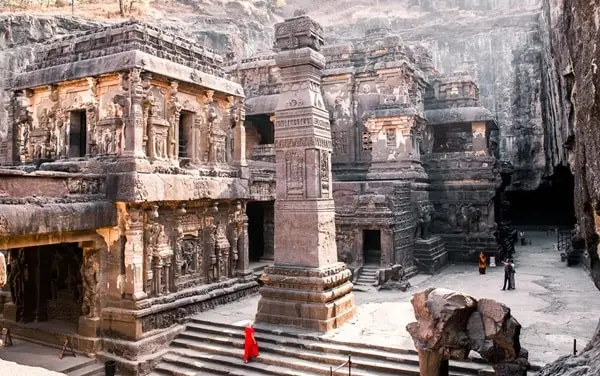Aurangabad, often referred to as the “City of Gates,” is a fascinating blend of history, architecture, and culture in Maharashtra. Known for its proximity to the UNESCO World Heritage Sites of Ajanta and Ellora Caves, Aurangabad is a treasure trove of ancient wonders and Mughal-era monuments. From the iconic Bibi Ka Maqbara, often called the “Mini Taj Mahal,” to the enchanting Daulatabad Fort, the city offers a rich historical journey for travelers. Beyond its architectural marvels, Aurangabad is also known for its vibrant markets, exquisite Paithani saris, and delicious local cuisine.
Choosing the best time to visit Aurangabad allows you to experience the city’s attractions with ease and comfort, as each season brings its own ambiance and opportunities. Here’s a guide on when to visit Aurangabad to make the most of its historical, cultural, and natural beauty.
Best Seasons to Visit Aurangabad

1. Winter (October to February)
Winter is considered the best time to visit Aurangabad, as the weather is cool and comfortable, with temperatures ranging from 10°C to 25°C. This season makes it ideal for exploring outdoor attractions such as Ajanta and Ellora Caves, which involve walking and hiking along pathways. The cool climate ensures that visitors can appreciate the intricate details of the rock-cut sculptures without the discomfort of heat or humidity.
The early morning hours in winter offer a particularly serene experience at the caves, with fewer crowds and gentle sunlight illuminating the detailed carvings. Bibi Ka Maqbara, Daulatabad Fort, and Panchakki (a 17th-century water mill) are also best enjoyed in winter, when you can explore these monuments without rushing.
Winter in Aurangabad also brings festive cheer, as Maharashtra celebrates Diwali in October or November. The city is adorned with lights, decorations, and cultural events, providing a vibrant cultural experience for visitors. Republic Day celebrations in January include parades and cultural programs, adding to the city’s dynamic atmosphere.
If you’re a fan of cultural performances, the Ellora Ajanta Festival, held in November, is a must-visit event. This festival celebrates classical Indian dance and music at the historic caves, offering an enchanting experience with the caves as a backdrop for live performances.
2. Summer (March to June)
Summer in Aurangabad can be quite hot, with temperatures often soaring above 40°C, especially in May and June. While the heat can make outdoor exploration challenging, visiting in early summer (March and April) is still manageable, especially if you plan your excursions in the early mornings or late afternoons to avoid the midday sun.
Summer is the off-season for tourism in Aurangabad, which means fewer crowds and the opportunity to explore attractions in relative peace. Ajanta and Ellora Caves, which offer shaded interiors, are more comfortable to explore during early mornings in summer. If you’re interested in photography, the golden light of sunrise and sunset provides stunning visuals of monuments like Bibi Ka Maqbara and Daulatabad Fort.
For travelers looking for budget options, summer also brings discounted rates on accommodations, making it a cost-effective season for visiting Aurangabad. However, it’s essential to carry water, wear light clothing, and use sun protection to stay comfortable during outdoor excursions.
3. Monsoon (July to September)
Monsoon brings a refreshing change to Aurangabad, with moderate to heavy rainfall transforming the dry landscape into a lush green paradise. Temperatures range from 20°C to 30°C, and while the rains add a certain charm to the city, they can also cause disruptions in travel plans.
The monsoon season enhances the beauty of Aurangabad’s historical sites, especially Daulatabad Fort and the nearby countryside, which take on a vibrant green hue. The view from the fort is particularly stunning during the monsoon, with the surrounding landscape blanketed in greenery. For photographers, the contrast of rain-washed stone monuments against the greenery creates striking visuals.
Monsoon is a good time for nature enthusiasts who appreciate the calm ambiance and the fresh feel that the rain brings. However, visitors should be prepared for intermittent showers and carry rain gear. Road conditions can also be challenging at times, especially when traveling to remote areas or hilly terrains.
Despite the rains, the Ellora Caves remain open during the monsoon season, allowing visitors to experience the beauty of these UNESCO World Heritage Sites in a quieter setting.
Key Attractions and Activities in Aurangabad
- Ajanta and Ellora Caves: These world-famous rock-cut caves showcase stunning ancient art and architecture. Ajanta’s Buddhist caves are adorned with murals depicting the life of Buddha, while Ellora’s diverse mix of Hindu, Buddhist, and Jain temples, including the monumental Kailasa Temple, is a marvel of engineering and art.
- Bibi Ka Maqbara: Often called the “Mini Taj Mahal,” this 17th-century mausoleum was built by Aurangzeb’s son in memory of his mother. The structure’s intricate carvings and Mughal-style gardens make it a beautiful and serene site to explore.
- Daulatabad Fort: This formidable fort, perched on a hill, is known for its complex defense mechanisms, including a narrow spiraling tunnel known as the “Andheri.” The panoramic view from the top is breathtaking, especially during the monsoon season.
- Panchakki (Water Mill): A unique 17th-century water mill and garden that was used to generate energy for grinding grains, showcasing the ingenuity of ancient engineering.
- Paithani and Himroo Shopping: Aurangabad is famous for its traditional textiles, including Paithani saris and Himroo shawls. A visit to local markets or weaving centers offers a chance to see artisans at work and purchase high-quality traditional garments.
- Aurangabad Caves: Located just outside the city, these lesser-known caves are a series of ancient rock-cut Buddhist shrines, known for their carvings and sculptures.
Practical Tips for Visiting Aurangabad
- Entry Tickets and Timings: Ajanta and Ellora Caves, as well as other monuments, have entry fees. The caves are closed on Mondays (Ajanta) and Tuesdays (Ellora), so plan accordingly.
- Local Transport: Taxis and auto-rickshaws are commonly available in Aurangabad. Many visitors also opt for private tours that include transportation to Ajanta and Ellora Caves, as these sites are located outside the city.
- Weather Considerations: Wear comfortable clothing suited to the season. Light, breathable fabrics are recommended for summer, while an umbrella or raincoat is useful during the monsoon. Warm clothing is advisable for early mornings in winter.
- Respect the Heritage Sites: Ajanta and Ellora Caves are protected sites. Visitors are encouraged not to touch or damage any sculptures or paintings and to avoid littering the premises.
- Accommodations: Aurangabad offers a variety of accommodation options, from budget hotels to mid-range lodges. Booking in advance is advisable during peak season, especially around the time of the Ellora Ajanta Festival.
Conclusion
Aurangabad is a city steeped in history, art, and culture, making it a must-visit destination for anyone interested in India’s rich heritage. From the cool, vibrant winters to the peaceful monsoon ambiance and the quieter summer mornings, each season brings its unique charm to Aurangabad. Whether you’re exploring the awe-inspiring Ajanta and Ellora Caves, marveling at Bibi Ka Maqbara, or simply enjoying the local flavors and textiles, planning your visit to align with your preferred season will make your journey even more rewarding. Experience the timeless beauty of Aurangabad, where the past meets the present in a tapestry of art, architecture, and tradition.


